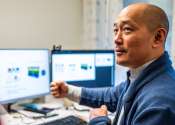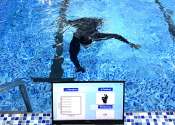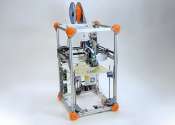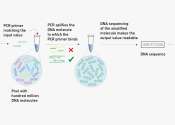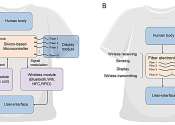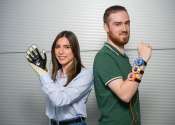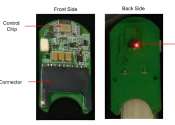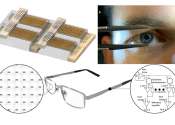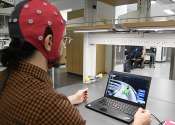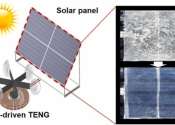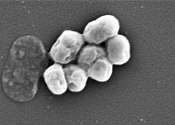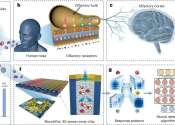Hi Tech & Innovation news
Robotics
Robotic insects could someday aid in mechanical pollination
With a more efficient method for artificial pollination, farmers in the future could grow fruits and vegetables inside multilevel warehouses, boosting yields while mitigating some of agriculture's harmful impacts on the environment.
2 hours ago
2
0
Energy & Green Tech
Comfortable materials use friction to generate power when worn
Researchers have demonstrated new wearable technologies that both generate electricity from human movement and improve the comfort of the technology for the people wearing them. The work stems from an advanced understanding ...
2 hours ago
0
0

CES 2025 unveils futuristic car tech: BMW, Honda, Toyota innovations
CES, formerly known as the Consumer Electronics Show, in Las Vegas continues to provide a sneak peek at future technology. The annual showcase includes advanced automotive tech in an industry striving to reduce pollution ...
6 hours ago
0
1

Novel OLED stacks enable exceptionally bright microdisplays
Users of augmented reality (AR) glasses require especially bright displays in daylight to clearly recognize content. High brightness and low power consumption are therefore crucial development goals, as optical systems—such ...
Jan 14, 2025
0
1

Next-generation wearables: Compact cooling pump drops temperatures by 16°F
UCLA materials scientists have developed a compact cooling technology that can pump away heat continuously using layers of flexing thin films. The design is based on the electrocaloric effect, in which an electric field causes ...
Jan 14, 2025
0
30
Engineering
Nature-inspired design uses elastic pillars to eject freezing droplets, preventing ice buildup
Water droplets under freezing conditions do not spontaneously detach from surfaces as they do at room temperature due to stronger droplet-surface interaction and lack of an energy transformation pathway. Since accumulated ...
Jan 14, 2025
0
22
Electronics & Semiconductors
Silicon photonics advance paves the way for cost-effective, high-performance optical devices
Imec, a research and innovation hub in nanoelectronics and digital technologies, has announced a significant milestone in silicon photonics with the successful demonstration of electrically driven GaAs-based multi-quantum-well ...
Jan 14, 2025
0
25
Hi Tech & Innovation

New training technique opens the door to neural networks that require much less energy
AI applications like ChatGPT are based on artificial neural networks that, in many respects, imitate the nerve cells in our brains. They are trained with vast quantities of data on high-performance computers, gobbling up ...
Jan 13, 2025
0
81
Computer Sciences

Ordering coffee with your feet: Study explores foot-based controls for augmented reality systems
Imagine controlling apps with your feet while you walk. This concept is the focus of new research which explores using gait gestures—intentional variations in how you walk—as controls for augmented reality (AR) devices.
Jan 13, 2025
0
19
Hi Tech & Innovation

How virtual reality technologies are shaping an inclusive future for architecture
Imagine stepping into your dream home before it is even built. Virtual reality (VR) technologies are revolutionizing architecture by allowing clients to walk through their future spaces, change details and experience the ...
Jan 12, 2025
0
0
Hi Tech & Innovation

Prime Video's use of AI, Next Gen Stats on NFL games is helping viewers understand the game better
The Los Angeles Rams defense appeared to be content to drop back in coverage and prevent San Francisco's Brock Purdy from completing a Hail Mary on the final play of their Thursday night game on Dec. 12.
Jan 11, 2025
0
1
Hi Tech & Innovation

A Minecraft-based benchmark to train and test multi-modal multi-agent systems
Researchers at the University of California- Los Angeles (UCLA) have recently developed TeamCraft, a new open-world environment for the training and evaluation of algorithms for embodied artificial intelligence (AI) agents, ...
Hi Tech & Innovation

AI-enabled technology is 98% accurate at spotting illegal contraband
Trying to spot contraband is a tricky business. Not only is identifying items like narcotics and counterfeit merchandise difficult, but the current most used technology—X-rays—only gives a 2D view, and often a muddy one ...
Jan 10, 2025
0
46
Energy & Green Tech

Innovative smart window technology balances heat and visibility control
Smart windows are becoming a key focus in the push for energy-efficient buildings and sustainable architecture. These windows can dynamically adjust their properties to control light and heat, improving comfort while reducing ...
Jan 9, 2025
0
2
Electronics & Semiconductors

Flexible electronics integrated with paper-thin structure for use in space
Being lightweight is essential for space structures, particularly for tools used on already small, lightweight satellites. The ability to perform multiple functions is a bonus. To address these characteristics in a new way, ...
Jan 9, 2025
0
17
Electronics & Semiconductors

Electrohydraulic wearable devices create unprecedented haptic sensations
Scientists at the Max Planck Institute for Intelligent Systems have invented compact wearable devices that deliver rich, expressive, and pleasant tactile sensations that go far beyond the buzzing vibrations of today's consumer ...
Jan 8, 2025
0
36
Consumer & Gadgets

A smart ring with a tiny camera lets users point and click to control home devices
While smart devices in homes have grown to include speakers, security systems, lights and thermostats, the ways to control them have remained relatively stable. Users can interact with a phone, or talk to the tech, but these ...
Jan 8, 2025
0
16
Hi Tech & Innovation

Invisible man: German startup bets on remote driver
With no one in the driver seat, the SUV pulling up resembles an autonomous robotaxi like those becoming increasingly present in some cities—but the car from German startup Vay is something else.
Jan 8, 2025
0
29
Engineering

Thermochromorph: A printmaking technique that transforms images with heat
Researchers in MIT Professor Stefanie Mueller's group have spent much of the last decade developing a variety of computing techniques aimed at reimagining how products and systems are designed. Much in the way that platforms ...
Jan 8, 2025
0
17
Hi Tech & Innovation

From AI assistants to holographic displays, automakers showcase in-cabin experiences at CES
Interior lighting aimed at reducing motion sickness. Shiny holographic dashboards displayed on windshields. And AI-powered voice assistants paired with infotainment systems to keep you company on long drives.
Jan 8, 2025
0
1
Electronics & Semiconductors

Engineers create photonic switch that overcomes routing size–speed tradeoffs
Every second, terabytes of data—the equivalent of downloading thousands upon thousands of movies at once—travel around the world as light in fiber-optic cables, like so many cars packed onto a super-fast highway. When ...
Jan 7, 2025
0
91
Business

Brain monitoring may be the future of work, but how it's used could improve performance or worsen discrimination
Despite all the attention on technologies that reduce the hands-on role of humans at work—such as self-driving vehicles, robot workers, artificial intelligence and so on—researchers in the field of neuroergonomics are ...
Jan 7, 2025
0
0
Energy & Green Tech

Plastic crystals could replace greenhouse gases used in refrigerators
A team of chemical engineers at Deakin University, working with colleagues from the University of Western Australia, the University of Sydney and Monash University, all in Australia, has found that a type of plastic crystal ...
Computer Sciences

Virtual platform enables real-time musical collaboration with avatars
Researchers are aiming to bring the magic of playing music in person to the virtual world. The Joint Active Music Sessions (JAMS) platform, created at the University of Birmingham, uses avatars created by individual musicians ...
Jan 3, 2025
0
1
Hi Tech & Innovation

From brain maps to living bridges: The innovations set to reshape life in 2025
From solar energy beamed from space to genetic brain maps and live self-repairing bridges, research in 2025 is promising. And we may see more changes that make cities greener and cleaner.
Dec 31, 2024
0
13




















